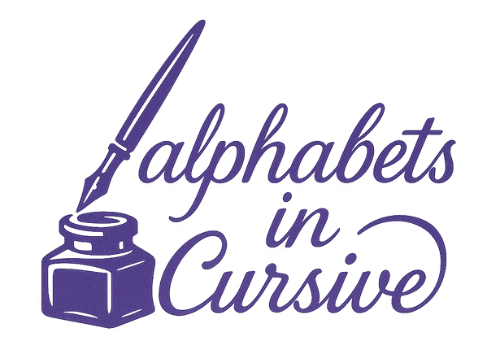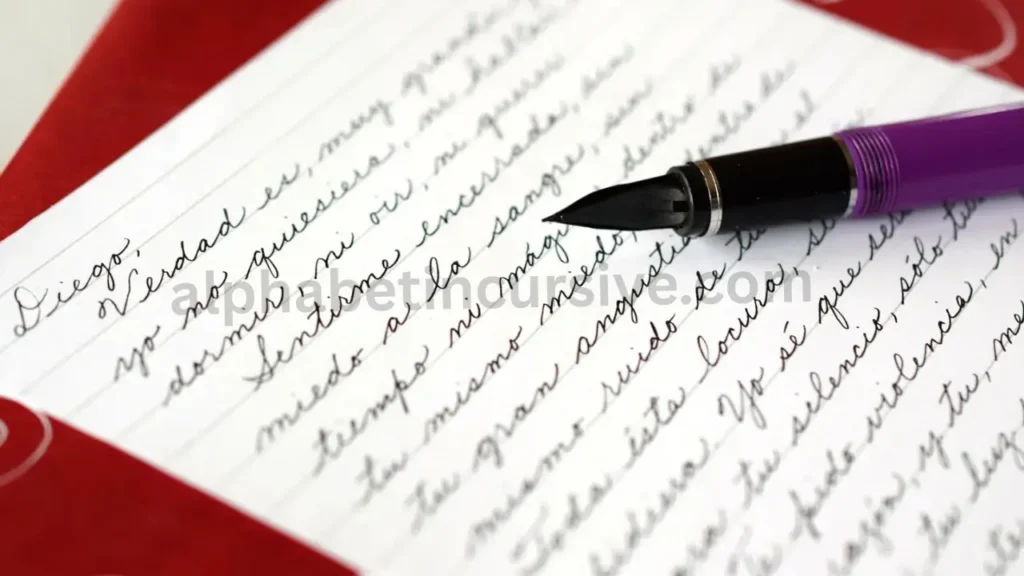Cursive Writing Made Easy: Mastering Alphabets in Cursive
Welcome to Alphabets in Cursive, your ultimate resource for mastering cursive writing. We offer free cursive worksheets, cursive alphabet guides, and step-by-step instructions to help you improve your handwriting skills. Ideal for students, teachers, and anyone looking to add elegance to their writing, our easy-to-follow resources make learning cursive writing both simple and enjoyable. Start perfecting your cursive handwriting with us today!

History and Origins of Cursive Writing
Cursive writing has a fascinating history, evolving from practical needs to artistic expressions across different eras. The earliest forms of cursive can be traced back to Roman times, with the use of shorthand in writing documents. Over time, this evolved into the cursive styles we recognize today.
In the 17th and 18th centuries, European calligraphers developed several cursive styles that became widely used. One such style is the Spencerian script, developed in the United States in the mid-1800s. In the 19th century, the Palmer Method and similar systems were introduced, teaching cursive as a standardized method for efficient handwriting.
Today, cursive is still taught in schools, used in signatures, calligraphy and artistic handwriting. Knowing its history helps us understand its importance and why we should learn cursive writing.
What is Cursive Writing?
Cursive writing is a unique form of handwriting where the letters of each word are joined together in a flowing, continuous motion. Unlike print writing, where each letter is separated, cursive allows for faster writing by keeping the pen on the paper throughout each word.
This writing style has been used for centuries to improve writing speed, efficiency, and fluidity. It is often introduced in schools to help students develop better handwriting skills while fostering a deeper connection between the brain and hand.
Think of cursive like learning to ride a bike. At first, the balance is tricky. But once you get going, it feels smooth. The letters connect, your hand moves without stopping, and soon you’re writing whole pages without lifting your pen much at all.
Why Does Cursive Writing Matter?
Cursive writing builds fine motor skills in the hands. The careful control needed to form loops and connections helps develop hand-eye coordination. This is similar to how playing a musical instrument helps with dexterity.
Writing in cursive helps with brain development. Studies suggest the act of writing by hand, especially in cursive, activates different parts of the brain compared to typing. This brain activity can help with memory and learning. It is like exercising your brain in a specific way.
How to Start Learning Cursive Writing?
Writing cursive involves understanding basic strokes and connections. Each letter has a specific starting point and ending point to prepare for the next letter. By following these simple steps, you’ll build confidence and skill one letter at a time.
1. Gather Your Tools
You don’t need fancy equipment to start. A good pen or pencil and lined paper will do. Lined paper helps keep your letters the right size and evenly spaced.
2. Learn Lowercase Letters First
Begin with lowercase letters. These are easier to connect. Letters like a, c, e, o all have simple shapes and are great starting points.
4. Use Tracing Worksheets
You can find many free cursive tracing worksheets online. Trace over the letters with your pen, then try writing them on your own.
5. Connect Letters to Form Words
Once you’re comfortable with individual letters, start joining them. Practice words like cat, dog, sun. Focus on smooth connections between letters.
6. Move to Uppercase Letters
Start learning uppercase cursive letters. These letters often have more loops and flourishes, but with practice, they become easier to write.
8. Practice Regularly
Consistency is key. Even 10 to 15 minutes of daily practice makes a big difference. Over time, your writing will become smoother, faster, and more natural.
Different Types of Cursive Writing Styles
Cursive isn’t one-size-fits-all. Several styles are used around the world, each with its own look and flow. Knowing the differences can help you choose the best one for your needs.
| Cursive Style | Characteristics |
|---|---|
| Zaner-Bloser | It features simple, round letters and a slight slant. It’s easy to read and a great choice for beginners. |
| D’Nealian | D’Nealian bridges the gap between print and cursive. Letters have small tails that prepare students for cursive connections. |
| Spencerian | Spencerian cursive is elegant and flowing. It features long loops and fancy strokes, making it more decorative. |
| Palmer Method | Palmer Method focuses on muscle movement and rhythm rather than detail. It’s good for fast, everyday writing. |
| Modern Cursive | Modern cursive mixes traditional forms with personal style. It may be less formal but more natural. |
Cursive Writing in the Digital Age
Even in the digital age, cursive writing holds value. While typing is common, the ability to write and read cursive remains a unique skill. It serves as a bridge between past and present forms of communication.
Many schools are reintroducing cursive or maintaining its instruction. They recognize its cognitive benefits and historical importance. The emphasis is often on understanding and reading cursive, even if daily writing is primarily typed.
Cursive is often used for signatures, certificates, and special occasions. These uses highlight its enduring formality and elegance. A diploma often has a cursive script to mark its importance.
Cursive writing vs. Print Writing
| Features | Cursive Writing | Print Writing |
|---|---|---|
| Letter Connection | Most letters connect in a flowing motion. | Each letter stands alone without connections. |
| Writing Speed | Usually faster because the pen lifts less often. | Slower due to frequent pen lifts between letters. |
| Legibility | Can be harder to read if not written neatly. | Generally more readable and consistent. |
| Use in Daily Life | Commonly used for signatures, handwritten cards, and personal notes. | More widely used in forms, labels, and early education materials. |
| Muscle Memory | Builds fine motor skills and rhythm due to its continuous motion. | Focuses more on shape and form, with less movement pattern. |
| Aesthetic Style | Has a flowing, decorative look. | Has a blocky, straightforward look. |
| Typing Transition | Less similar to keyboard fonts, which can make the switch to typing less direct. | Closely resembles typed text, making it easier for children to relate to digital writing. |
How to Teach Cursive Writing to Kids
Teaching kids how to write in cursive works best when it’s broken into fun, manageable steps. Here’s how to make it stick.
Start with Simple Strokes
Use play-based methods to teach basic shapes. Let kids trace curves, loops, and lines using pencils, crayons, or even their finger in sand or shaving cream.
Introduce Letters in Groups
Teach similar-looking letters together—like c, a, d—so kids spot patterns. This builds memory and cuts confusion and makes easy to learn cursive writing.
Keep Practice Sessions Short
Ten minutes of focused writing is better than 30 minutes of frustration. Use lined worksheets to support shape and size.
Celebrate Progress
Praise neat letters, even if they’re not perfect. Confidence boosts learning. Try using sticker charts or letting kids write their name in cursive on special projects.
Add Fun Activities
Turn learning into games—match letters, copy short words, or use dry erase boards. The more fun it feels, the more likely kids will stay engaged.
Be Patient
Some children take time to build the muscle control needed for cursive. Progress will come with time and gentle guidance.
Common Problems in Cursive Writing
Everyone hits a few bumps when learning cursive. Most issues come down to habits, posture, or skipping the basics. Here’s how to handle them.
1. Letters Look Uneven
If some letters look bigger or smaller than others, use lined paper to guide your height. Keep lowercase letters between the midline and baseline, and make sure uppercase letters touch the top line.
2. Letters Are Hard to Read
This usually means the strokes are too close or too wide. Try writing slower and watch how you connect letters. Start with simple two-letter pairs like an, it, or until the flow feels right.
3. Writing Slants Too Much
Cursive has a natural tilt to the right, but if it leans too far, adjust your hand position. Make sure your wrist and fingers move together. Don’t twist your paper too much either—keep it at a slight angle.
4. Your Hand Gets Tired
This often means you’re gripping the pen too tight. Hold it gently and let your arm do the work. Use warm-up exercises like loops or lazy 8s before starting longer writing tasks.
5. Letters Don’t Connect Smoothly
Check your exit and entry strokes. Most letters start or end with small loops or tails that link to the next letter. If you lift your pen too often, the writing will break apart.
Best Resources for learning Cursive Writing
Our website offers practical tools and pages to make learning cursive easy and enjoyable. Here’s a quick look at what you can use right now:
Tips for Improving Your Cursive Handwriting
Even if you already know the basics, small changes can make your cursive look cleaner and feel easier to write. These tips will help sharpen your skills and build good habits.
- Sit Up Straight and Relax Your Grip: Sit with your back straight, feet flat on the floor, and paper angled slightly. Hold your pen lightly.
- Keep Your Letters Even: In cursive, rhythm matters. Try to keep the height of your lowercase letters the same.
- Use Practice Lines: Writing on lined paper or worksheets helps maintain control. Aim to keep your letters within the lines.
- Warm Up Before You Start: Just like stretching before exercise, try writing loops, waves, or circles on paper to loosen your hand.
- Read Your Own Writing: After writing a few sentences, take a step back. Can you read everything clearly? If not, check which letters caused confusion and go back to practice those shapes.
- Try Different Pens: Experiment to see what suits your hand best. A gel pen, fountain pen, or fine-point ballpoint might help your letters look more fluid.
- Don’t Skip the Practice: Even five minutes a day keeps your skills sharp. Like playing an instrument, regular use makes the motion feel more natural and automatic.
Cursive writing is more than fancy loops and curves. It’s a skill that supports muscle control, reading fluency, and personal expression. By starting with the basics, choosing a style that fits your needs, and sticking to short, steady practice sessions, anyone can learn to write in cursive.

